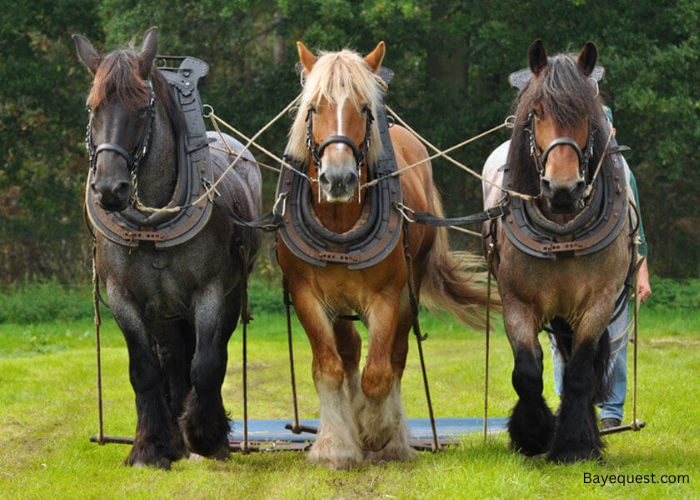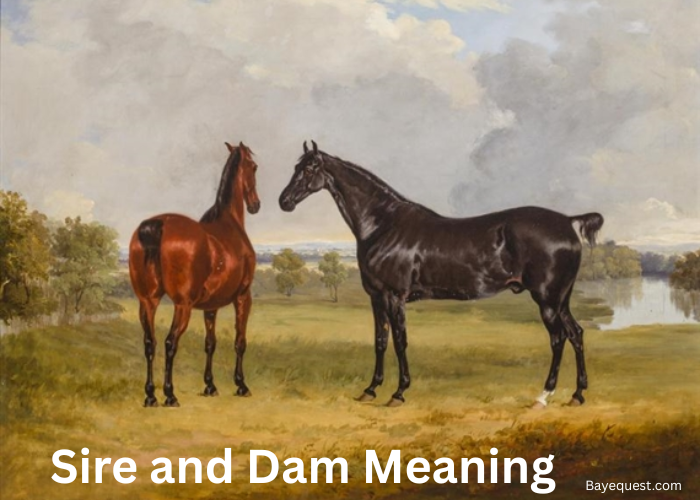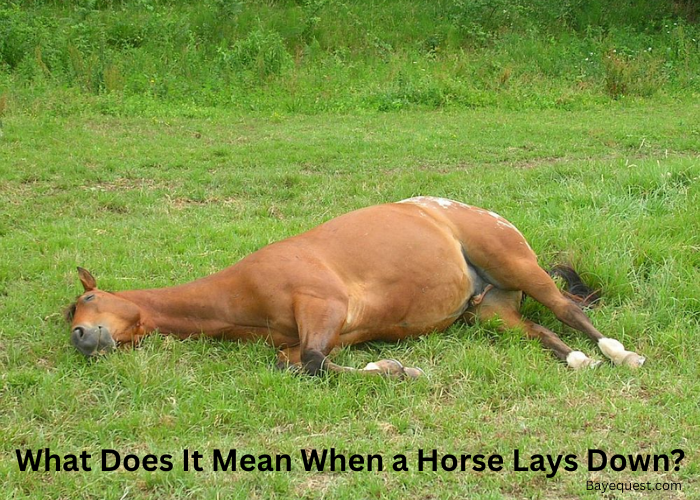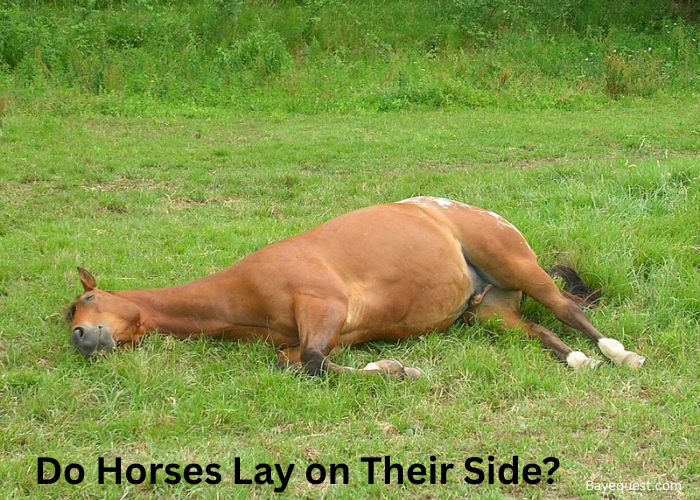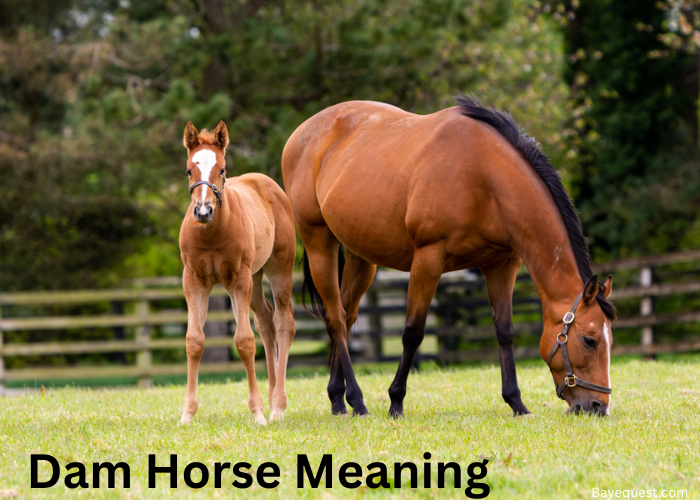Horses come in all shapes and sizes, but the largest breeds are truly something special.
These towering giants stand out with their massive frames and commanding presence.
Their height and strength make them unique among their kind, turning heads wherever they go.
Whether on farms, in parades, or simply grazing in a field, these breeds are impossible to ignore. Their sheer size sparks curiosity and amazement.
Let’s dive into the world of the largest horse breeds and discover what makes them so remarkable.
What’s the Biggest Horse Breed in the World? Key Takeaway
The Shire horse holds the title of the biggest horse breed in the world. Shires have an impressive size, standing between 16 to 18 hands (64 to 72 inches) tall and weighing over 2,000 pounds. Exceptional Shires have reached heights of up to 19 hands (76 inches) and weights approaching 3,000 pounds.
Who was the Biggest Horse Ever?
The biggest horse ever was a Shire named Mammoth. He stood a towering 21.2 hands tall, feet 2 inches at the shoulder, and weighed an incredible 3,300 pounds.
Born in England in 1848, Mammoth was truly a giant among horses. His immense size and strength made him legendary, and he still holds the record as the tallest and heaviest horse ever recorded.
If you can imagine a horse that size, you’d look up at him like he’s a skyscraper.
The World’s Biggest Horse Breeds
Some of the world’s largest horses are:
1. Shire (World’s largest horse)
The Shire is a towering breed, standing between 16 and 18 hands tall and weighing over 2,000 pounds.
With a muscular build, broad chest, and long, powerful legs adorned with beautiful feathering, they are both strong and majestic.
Originally bred in England, Shires were war horse breeds, carrying knights in heavy armor.
Over time, they became essential for farming and hauling heavy loads. Today, they continue to serve in farming, parades, and draft horse competitions.
Shires have a gentle and calm temperament. Despite their impressive size, they are easy to handle and eager to work.
Their care requires a diet rich in hay and grain to sustain their large bodies, along with ample space for exercise.
See also: What is the Lifespan of Shire Horses?
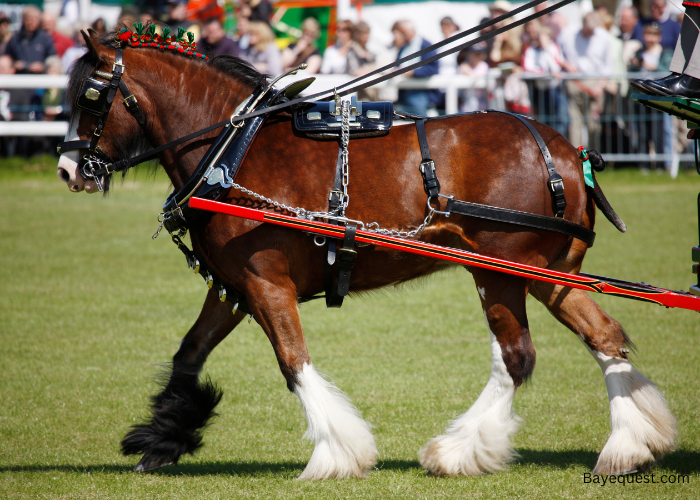
2. Clydesdale
The Clydesdale is among the largest and most distinctive horse breeds. They stand between 16 and 18 hands high and weighing around 1,800 to 2,000 pounds.
With a powerful build, broad chest, and striking white markings on their legs and face, they are both strong and elegant.
Their flowing manes and feathered legs add to their majestic appearance.
These horses originated in Scotland’s Clyde River Valley in the 18th century, where they were bred for heavy farm work and hauling loads.
Their strength and steady gait made them highly effective for plowing fields and transporting goods.
Today, they are often seen pulling the iconic Budweiser beer wagons in parades and commercials.
Clydesdales are gentle giants with a calm and friendly nature, making them suitable for work and show alike.
Read also: Difference Between Clydesdale and Regular Horse.
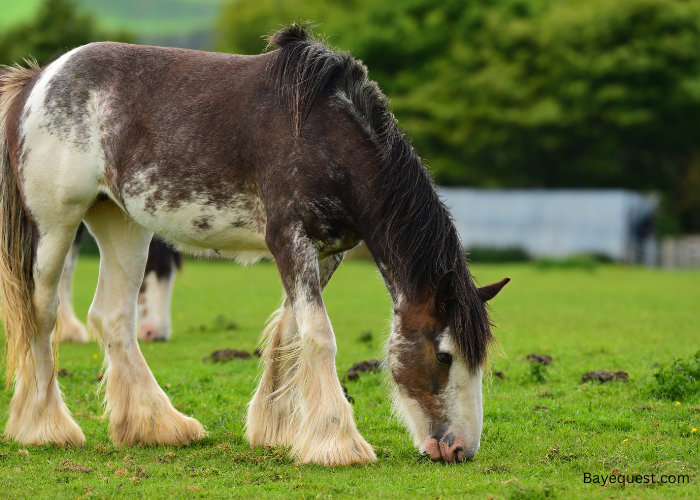
3. Percheron
Standing between 15 and 19 hands tall and weighing 1,800 to 2,600 pounds, this breed is a true heavyweight with a muscular build, strong legs, and an arched neck that combines power and grace.
Originating in the Perche region of France, these horses were initially bred for war, carrying knights into battle.
Over time, their strength and stamina made them invaluable for farm work, pulling carriages, and forestry. They continue to be used in farming, parades, and draft competitions.
Percherons handle various tasks with ease, making them reliable and versatile partners.
Proper care includes a diet of high-quality hay and grain, ample space for exercise, and regular grooming to maintain their thick, shiny coats. Clean and well-trimmed hooves are also essential for their health.
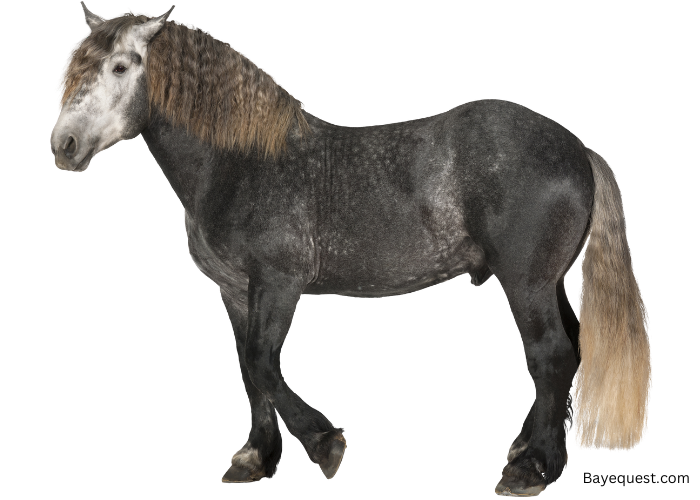
4. Belgian Draft
Standing 16 to 18 hands high and weighing between 1,800 and 2,200 pounds, the Belgian draft combines immense power with a gentle demeanor.
With muscular bodies, broad chests, and strong legs, they are built for strength but move with surprising grace.
Originating in Belgium, these horses have been used for centuries in farming and hauling heavy loads.
Their strength and calm temperament made them ideal for plowing fields and pulling carts. Today, they can be seen in parades, draft horse shows, and modern farming.
Hardworking and friendly, they are reliable partners for heavy tasks.
See also: Average Belgian Horse Lifespan.
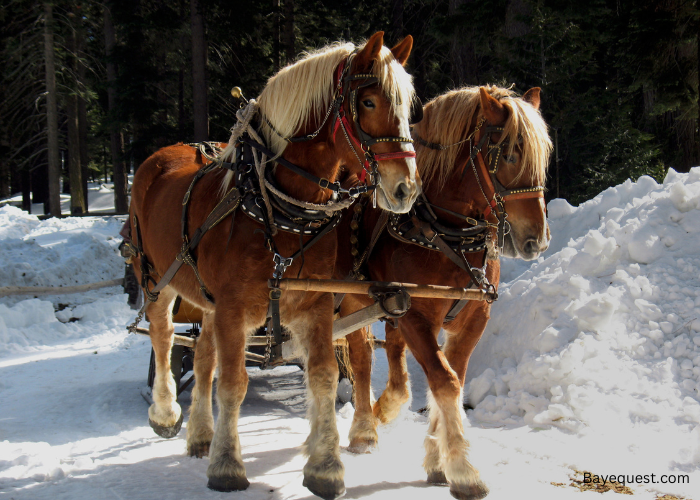
5. Dutch Draft
The Dutch Draft is a powerhouse of a horse, weighing between 1,500 to 1,700 pounds and standing 15 to 17 hands tall.
With broad, muscular bodies, thick necks, and strong legs, these horses are perfectly designed for heavy labor.
Developed in the Netherlands after World War I, Dutch Drafts became essential for pulling plows, carts, and performing hard farm work.
Their unmatched strength and endurance helped restore agriculture during challenging times.
Today, they remain a popular choice for farming, forestry, and pulling carriages in parades and events.
Despite their size, Dutch Drafts have a calm and gentle temperament, making them easy to handle.
They are reliable, hardworking, and always ready to tackle demanding tasks.
Caring for them involves providing plenty of hay, grain, and fresh water to meet their energy needs.
They also need ample space to stretch and move freely.
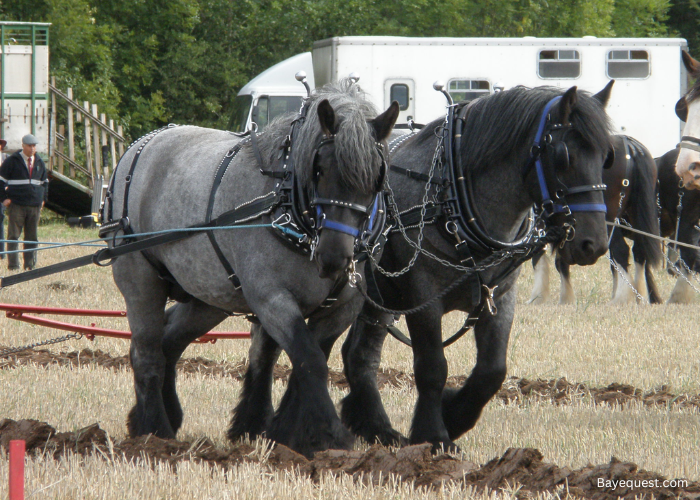
6. Australian Draught
The Australian Draught is a big, muscular horse built for heavy work. It stands around 16 to 18 hands high and weighs between 1,600 and 2,000 pounds. It’s both strong and sturdy, with a broad chest, powerful legs, and a solid, compact frame.
Developed in Australia in the early 19th century, this breed is a mix of Shire, Clydesdale, Percheron, and Suffolk Punch bloodlines. They were bred to handle tough farm tasks and heavy hauling in Australia’s terrain.
Australian Draughts are known for their calm and cooperative temperament. They’re hardworking and reliable, ideal for farm work and logging.
They need a diet rich in hay and grains to keep their energy up and plenty of room to exercise. Regular grooming helps maintain their coat and hooves, especially given their demanding roles.
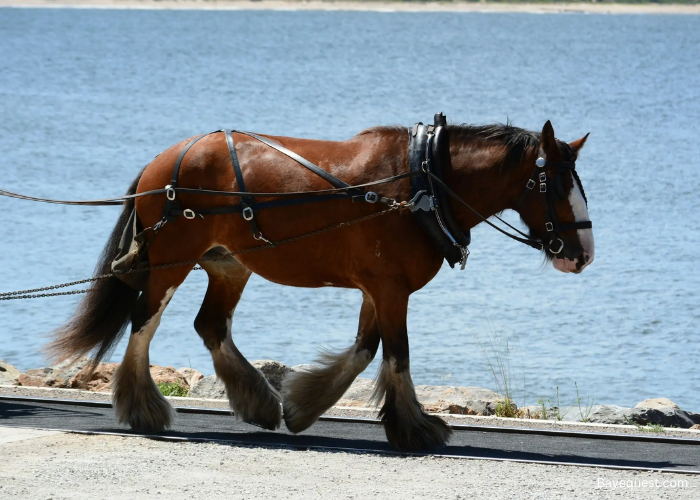
7. Suffolk Punch
The Suffolk Punch is a strong and sturdy horse. It stands 16 to 17 hands tall and weighs between 1,600 and 2,000 pounds.
Its broad chest, deep body, and rich chestnut coat make it easy to recognize.
This breed was developed in Suffolk, England, in the 16th century.
It was bred specifically for farm work. Its strength and endurance made it perfect for plowing fields and pulling heavy loads.
These horses are calm, hardworking, and dependable. They are willing workers and great partners for farmers.
To care for them, provide a diet of hay and grain to keep their energy up. Regular exercise is also important to keep them fit.
Grooming is simple, but you need to check their joints and hooves to keep them healthy.
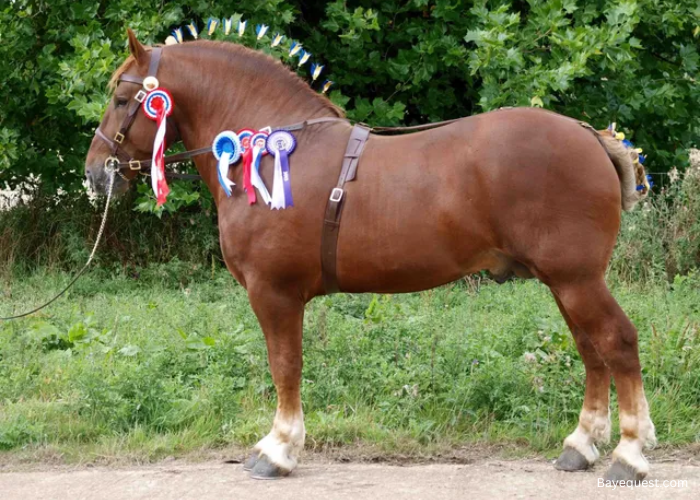
8. American Cream Draft
The American Cream Draft is a real standout among big horses. They usually stand around 15 to 16 hands high and weigh between 1,500 to 2,000 pounds.
Their most striking feature is their beautiful, cream-colored coat, pink skin, and amber eyes that give them a unique and elegant look.
Originating in Iowa in the early 20th century, the American Cream Draft was bred for farm work. A mare named Old Granny is the breed’s foundation, and her rare champagne-colored coat became a defining trait.
These horses were developed to be strong enough for heavy farm work but still gentle and manageable.
American Creams are known for their calm and friendly nature. They’re easy to train and willing to work, making them great for farming and driving.
They need a good diet of hay and grain and benefit from regular exercise to keep their muscles strong. Their light-colored skin can be sensitive, so they need protection from too much sun.
Read also: Average Draft Horse Lifespan.
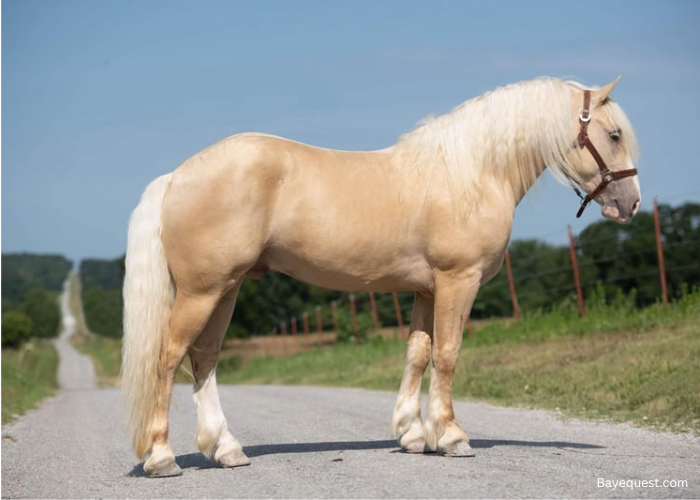
9. Vladimir Draft
These horses stand between 15.2 and 16.2 hands high and weigh around 1,500 to 1,800 pounds. Their muscular build, broad backs, and strong legs give them an impressive and powerful look.
Bred in Russia’s Vladimir region in the early 20th century, these horses were created by crossing local draft mares with imported Shire and Clydesdale stallions.
The goal was to develop a breed that could handle heavy farm work and long-distance hauling in tough conditions.
Vladimir Drafts are known for their strength and endurance. They’re calm and reliable, perfect for heavy pulling tasks, from logging to plowing fields.
They need a good diet of hay and grain to maintain their strength and energy, along with regular exercise. Grooming is essential to keep their coats and hooves in good shape, especially given their size and workload.
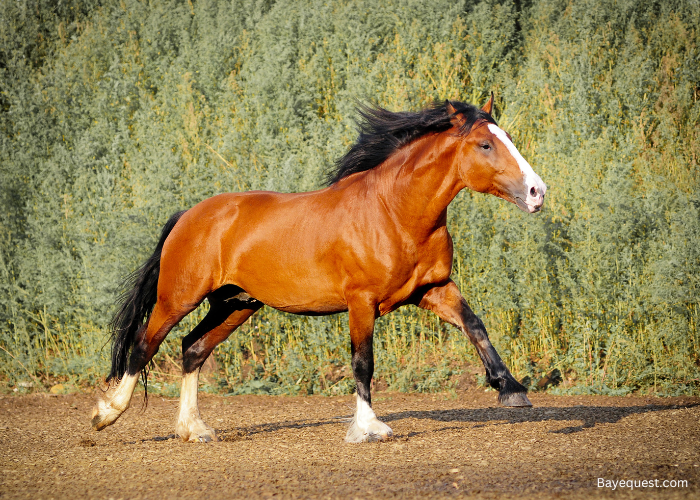
10. Russian Heavy Draft
The Russian Heavy Draft is a strong and sturdy horse. It stands between 14.2 and 15.2 hands high and weighs 1,400 to 1,800 pounds.
Its muscular frame, thick neck, and powerful legs are built for strength and endurance.
This breed was developed in Russia during the 19th century. It was created by crossing local
Russian horses with imported draft breeds to handle heavy loads and tough conditions. These horses are well-suited for farming, logging, and pulling carts.
Calm and hardworking, the Russian Heavy Draft is reliable and steady in demanding tasks. It thrives on a diet of high-quality hay and grain to maintain energy levels.
Regular grooming is essential to keep its coat and hooves healthy, especially when working in challenging environments.
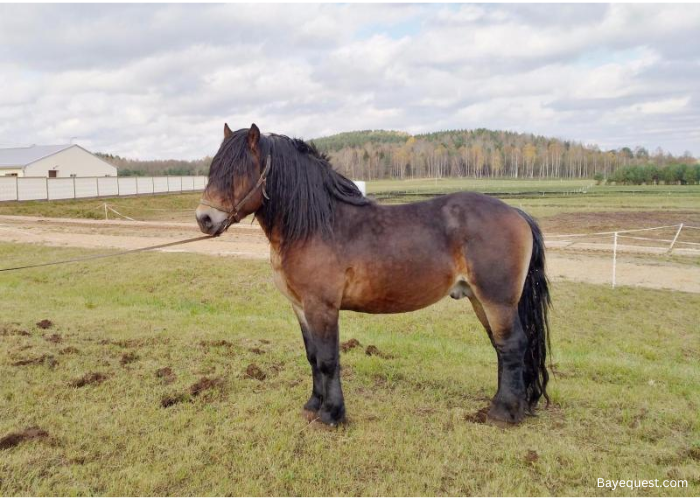
11. Lithuanian Heavy Draft
The Lithuanian Heavy Draft is a robust and powerful breed. They usually stand between 15 and 17 hands tall and weigh about 1,500 to 2,000 pounds.
These horses have a solid, muscular build, broad backs, and strong legs, making them perfect for heavy labor.
Bred in Lithuania in the 19th century, the Lithuanian Heavy Draft was created to meet the demands of agriculture and industry.
It was developed by crossing native horses with heavier draft breeds to produce a horse that could handle tough farm work and pull heavy loads.
These horses are known for their calm and hardworking temperament. They’re reliable and ideal for plowing, logging, and pulling heavy carts.
They need a diet rich in hay and grains to fuel their work and plenty of room to move around.
Regular grooming is important to keep their coats and hooves in good shape, especially when working in muddy or rough conditions.
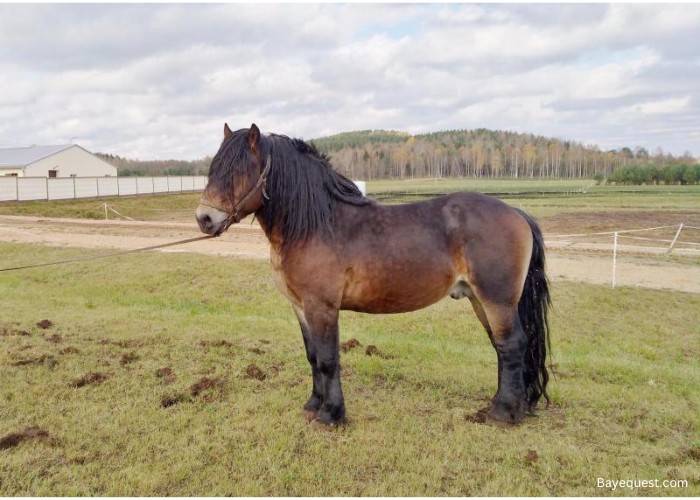
12. Jutland
The Jutland is a strong and solid draft horse, standing 15.2 to 16 hands tall and weighing between 1,400 and 2,000 pounds.
It has a muscular build, a broad chest, and powerful legs, all covered in a thick chestnut coat with a shiny mane and tail.
This breed was developed in Denmark’s Jutland Peninsula during the 19th century.
It was bred to be a powerful workhorse, used for farm work, logging, and hauling heavy loads in both rural and urban areas.
Its strength and reliability made it vital for agricultural and industrial tasks.
Jutlands are calm and friendly, making them dependable partners for heavy labor. They work hard and handle demanding tasks with ease.
Caring for them involves feeding a diet of hay and grains to meet their energy needs.

13. Ardennais
The Ardennais, or Ardennes, is a robust and powerful draft horse.
Standing around 15 to 16 hands high and weighing between 1,500 and 2,200 pounds, they have a muscular build, broad chests, and strong, short legs. Their thick coats help them withstand harsh weather.
They originate from the Ardennes region of France, Belgium, and Luxembourg, and have a history that dates back thousands of years.
They were bred for heavy farm work, forestry, and hauling loads in tough terrains.
Their strength and endurance were invaluable for plowing fields and pulling artillery in wartime.
Ardennais horses have a calm and patient temperament. They’re steady and dependable, ideal for demanding tasks like logging and farm work.
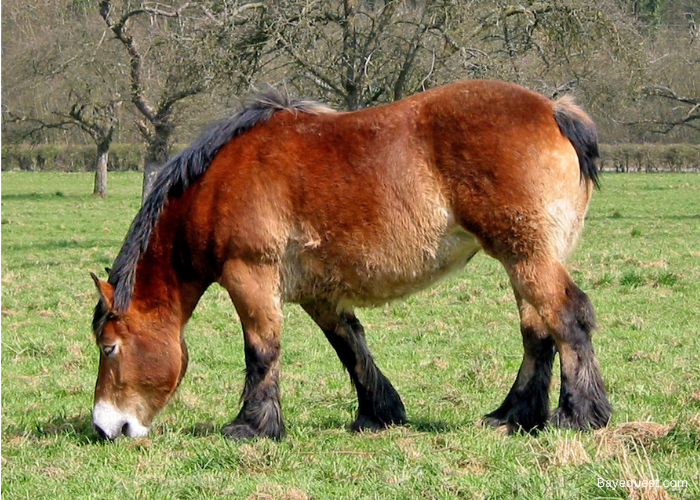
14. Boulonnais
The Boulonnais is a striking and elegant draft horse with a powerful physique.
Standing between 15.2 and 16.3 hands high and weighing around 1,500 to 1,800 pounds, it has a solid, muscular build, a broad chest, and a short, strong back.
Its sleek gray or white coat gives it a refined, majestic appearance.
Hailing from northern France, the Boulonnais breed has a history stretching back to Roman times.
They were originally used to haul fishing boats, and later became famous for transporting goods and heavy loads.
Today, they’re celebrated for their beauty and strength, often seen in parades and ceremonial events.
Boulonnais horses have a gentle and docile temperament. They’re hardworking and patient, making them excellent for farm work and driving.
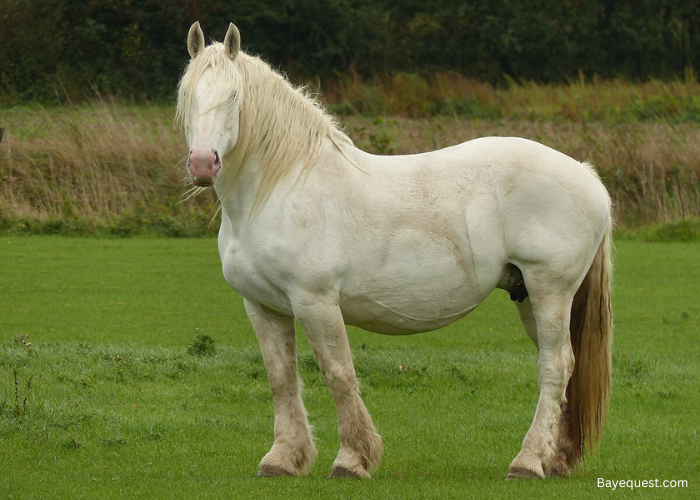
15. Comtois
The Comtois is a sturdy and muscular draft horse. They stand between 15 and 16 hands high and weigh around 1,500 to 1,800 pounds.
Comois have thick necks, broad chests, and strong legs, a distinctive chestnut coat with flaxen manes and tails.
Originating from the Jura Mountains in France, the Comtois breed dates back to the Middle Ages. They were bred for both agricultural work and as war horses, valued for their strength and resilience.
Today, they’re still used for farming, forestry, and pulling carriages in parades.
Comtois horses have a calm and willing nature. They’re hardworking and reliable, making them ideal for heavy labor.
They need a diet rich in hay and grains to maintain their energy levels and regular exercise to stay fit. Their thick coats require regular grooming to prevent matting, especially in rough working conditions.
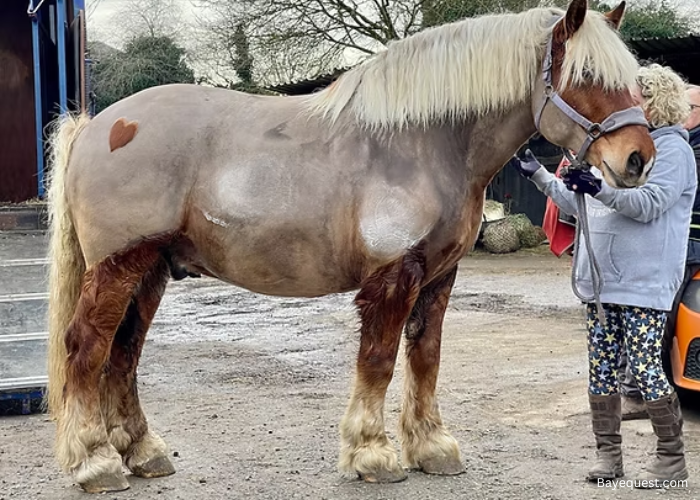
16. Irish Draught
The Irish Draught is a big and versatile horse, standing between 15.2 and 17 hands high and weighing around 1,400 to 1,700 pounds.
They have a solid build, deep chests, powerful hindquarters, and strong legs, yet they’re surprisingly agile.
The Irish Draught has been around since the 18th century. It was bred in Ireland to be tough and adaptable, handling heavy labor and lighter riding tasks easily.
These horses were originally used for farming, pulling carts, and even riding into town.
They’re hardworking, calm, and versatile, perfect for everything from farm work to competitive sports like show jumping and eventing.
To stay fit and healthy, they need a balanced diet of hay and grain and regular exercise.
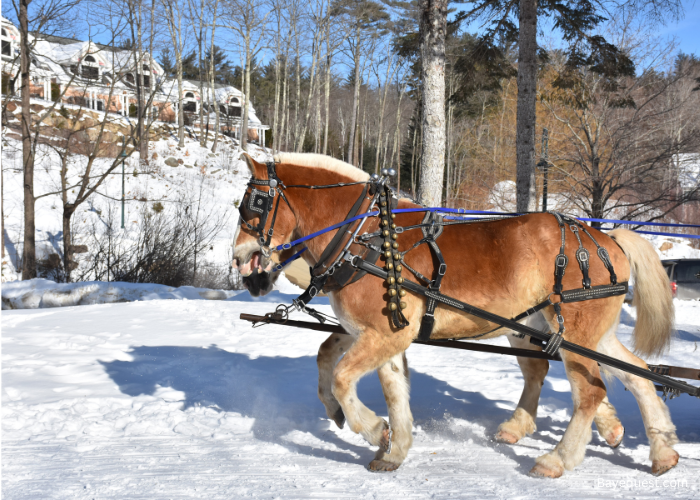
17. Dole Gudbrandsdal
The Dole Gudbrandsdal, or Dole, is a compact and powerful horse. It stands between 14.1 and 16 hands tall and weighs 1,200 to 1,500 pounds.
Its muscular build, thick neck, and strong legs make it well-suited for heavy work.
This breed originated in Norway’s Gudbrandsdal Valley during the Middle Ages.
It was developed from local Norwegian horses and influenced by Friesian and heavy draft breeds to endure rugged terrain and cold climates.
Initially bred for farm work and pulling heavy loads, the Dole is also versatile and used for riding and driving.
Its steady and reliable nature makes it ideal for tasks like plowing fields, logging, and pulling carriages.
To keep them healthy, Doles require a diet rich in hay and grains for energy and enough space for exercise.
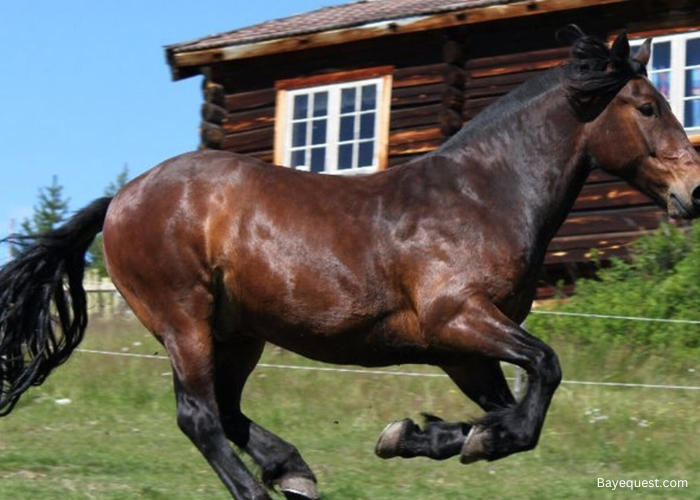
18. Friesian
The Friesian stands out among the largest horse breeds, known for its striking appearance and graceful build.
They stand between 15.2 and 17 hands high, weighing around 1,200 to 1,500 pounds.
They have a muscular frame, elegant arched neck, long, flowing mane and tail. Their coat is almost always black, giving them a majestic look.
Friesians originate from the Friesland region of the Netherlands, and have a history that dates back to the Middle Ages.
They were used as war horses and later for farming and carriage driving.
Today, due to their flashy appearance and high-stepping trot, they’re famous for dressage, show driving, and even riding in films.
Friesians are gentle and have a willing nature. They’re intelligent, calm, and versatile, making them great for various roles.
Like the other breeds, they need a good diet of hay and grains, plenty of exercises to keep fit.
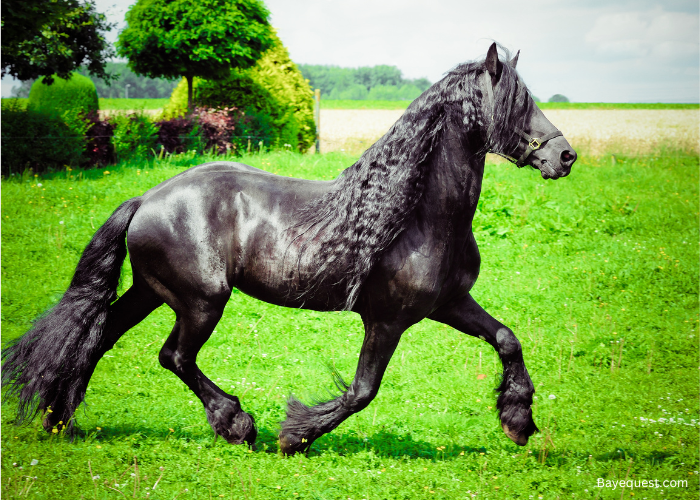
19. Fjord
The Fjord horse is a compact powerhouse. Though they stand only about 13.2 to 14.2 hands high and weigh between 900 and 1,200 pounds, they’re incredibly strong and sturdy for their size.
Their distinctive appearance includes a thick neck, strong back, and a unique mane that’s often trimmed to stand upright, showing off their black-and-white stripes.
Originating from Norway, the Fjord horse has been used for centuries, dating back to the Viking era.
They were bred for their versatility, handling everything from farming and logging to riding and driving.
Their strength and sure-footedness make them ideal for working in rugged terrains.
Fjords are known for their friendly and willing nature. They’re intelligent, gentle, and versatile, perfect for work and pleasure.
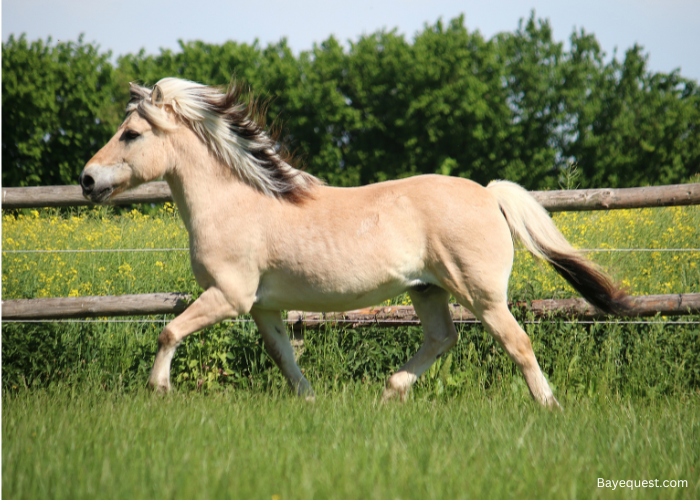
How is Horse Height Measured?
Horse height is measured in hands. One hand is equal to four inches. To measure a horse, you go from the ground to the highest point of the withers, the ridge between the shoulder blades.
You use a measuring stick or tape that shows hands and inches. For example, if a horse is 15 hands, that means it’s 60 inches tall at the withers. If it’s 15.2 hands, it’s 62 inches tall.
Simple, straightforward, and no fancy tools are needed.
What is the Average Weight for Large Breeds of Horses?
The average weight for large horse breeds usually falls between 1,500 and 2,200 pounds. These hefty horses, like Shires or Clydesdales, are built for strength and stamina.
Their solid, muscular bodies pack a lot of power, which is why they’re so good at pulling heavy loads or working long hours in tough conditions.
So, when you think of a big horse, picture something around that weight range. It’s like having a small car standing in the barn.
Interesting read: How Much Do Horses Weigh?
Largest Breeds of Horses: Conclusion
The largest horse breeds are more than just their size—they’re a testament to nature’s ability to create something truly breathtaking.
Each breed carries its own story, shaped by centuries of purpose and resilience.
Their sheer scale and majestic presence are enough to leave anyone in awe.
But size is just one part of the picture. The world of horses is vast and full of surprises, and there’s always more to uncover. Isn’t that exciting?




